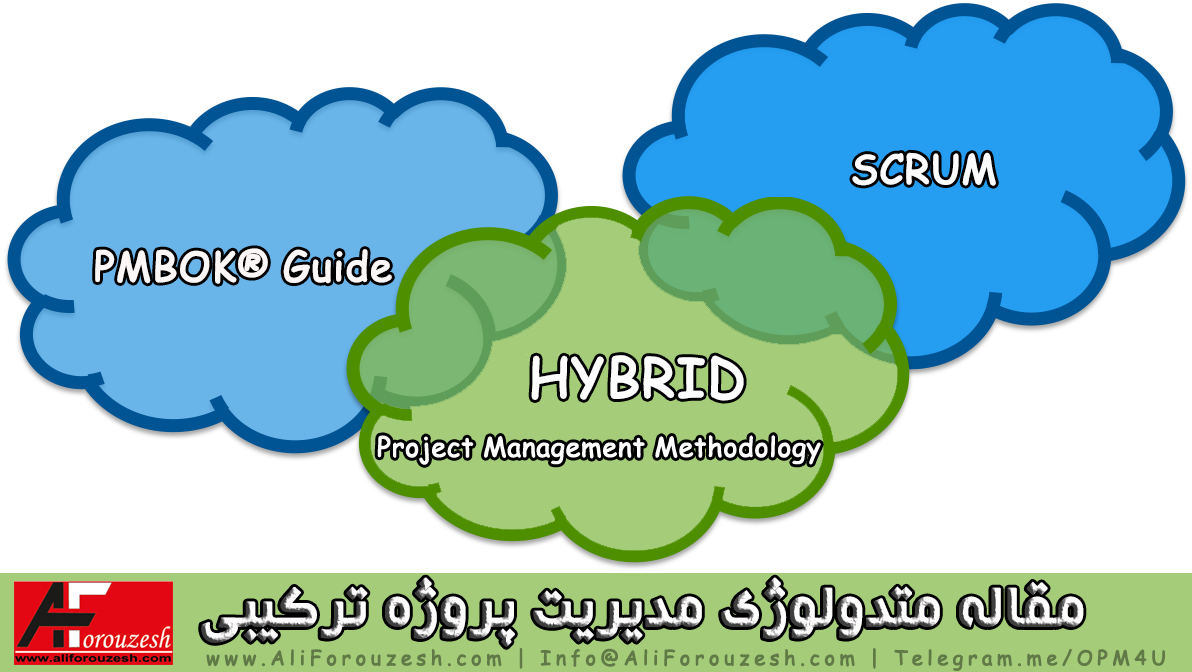 متدلوژی مدیریت پروژه ترکیبی (Hybrid Project Management Methodology) : Several months ago, I had a consultancy meeting with one of my clients in the telecommunication sector. A meeting with the PMO manager and his crew was about selecting the right and sufficient project management methodology for the PMO department. They had been using a methodology that was developed using A Guide to the Project Management Body of Knowledge (PMBOK® Guide)—Fourth Edition for three years. The company has more than 5,500 people and 30 live projects.
متدلوژی مدیریت پروژه ترکیبی (Hybrid Project Management Methodology) : Several months ago, I had a consultancy meeting with one of my clients in the telecommunication sector. A meeting with the PMO manager and his crew was about selecting the right and sufficient project management methodology for the PMO department. They had been using a methodology that was developed using A Guide to the Project Management Body of Knowledge (PMBOK® Guide)—Fourth Edition for three years. The company has more than 5,500 people and 30 live projects.
It has several competitors, and the economy and technology are unpredictable external factors—so it has to complete and deliver its projects quickly and efficiently.
Let’s get back to the meeting. I asked the PMO manager to explain current and upcoming projects to me. The company had been using MS Project Server 2013 as a PMIS. The manager and team showed me the project portfolio dashboard, which included more than 30 projects, sub-programs and programs. After that, the PMO manager described the project portfolio components. Finally, he said that the reason behind inviting us was that the company CEO wanted to be more agile. They wanted us to find a way to deliver the project’s value more quickly.
Before asking about their project management methodology, I asked them to describe their project types. In a nutshell, they divided their projects in two categories:
- IT services projects such as customer portal, CRM, value-added services (VAS) portal, etc.
- Networking services projects such as core network rollout, BTS installation, site administrative management (SAM), radio and core optimization, etc.
The PMO manager described their project management methodology. They have developed and customized the Telecom Enterprise Project Management Methodology (TEPMM) based on PMBOK® Guide—Fourth Edition and used it on whole projects.
If you look back to the categories, you can find that they have completely different elements. The first category had a change-driven development element because they were software projects. In the information technology projects, we can’t define product and project scope comprehensively (and in full detail) in advance. Most of the time, we have to change the features and requirements. We should also deliver some parts of the product during the project because early and continuous delivery is vital in the software industry. Then we have to structure the project and team to deliver value early and frequently.
On the other hand, the second category had a plan-driven development component because of the hardware and site installation, core network rollout, etc. In this category, project and product scope were clear. Most of the time, we can use waterfall methods and sequential phases. They used TEPMM for both IT services and networking services projects. However, they were encountering two problems:
- Some programs and projects included both categorizations.
- The TEPMM was heavy for projects in the first category.
Monitoring and controlling the project portfolio based on this unique approach
I recommended a hybrid Scrum/PMBOK® Guide methodology that we called TEPMM2. It included all of the principles and elements identified in both Scrum and PMBOK® Guide. In this methodology, we use the PMBOK® Guide as an external layer and Scrum as an internal layer. The external layer includes project management processes, and in the internal layer we have product management processes:

Figure 1.1: Part of TEPMM2 methodology
After approving the project charter, we should collect requirements and define the product backlog, so we should use the decomposition technique. The project is broken down into manageable items either by discipline (installation, software, networking, etc.) or by functionality. At the lowest level of the WBS, we will have a list of work packages. Based on those elements (linear or incremental), we put them into one or more sprints. For example, installation hardware is linear, and implementing user login is incremental (because of intellectual property issues, I can’t publish the complete methodology framework).
In conclusion, many companies and organizations that work in different industries encounter the same challenges, specifically in the IT, EPC, telecom and R&D industries. They have both plan-driven and change-driven projects. Sometimes, some part of a project is best suited to an agile approach, while other parts to a PMBOK® Guide approach. So implementing a hybrid methodology can be more effective and useful, because traditional approaches are so heavy and complex for incremental projects or works. In some projects we have both approaches (agile and traditional) together, so applying a methodology that supports that is important.

